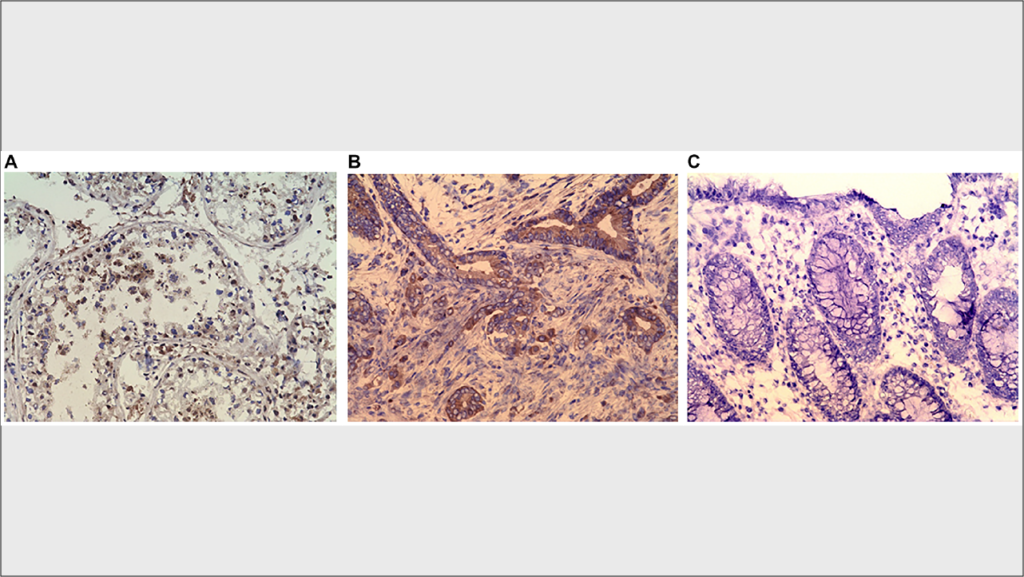Researchers evaluate CABYR isoforms a/b and c mRNA expression in colorectal cancer in hopes of determining whether or not these proteins may be promising immunotherapy targets.

The human germ line is defined as the non-somatic reproductive cells found in the eggs and sperm. In patients with tumors/cancers associated with the reproductive organs, scientists and researchers often seek possible targets for new therapies by identifying proteins expressed only in the germ line, and not in normal tissues.
Researchers—from Northwell Health, Memorial Sloan-Kettering Cancer Center, Columbia University, University of Vermont Medical Center, City University of New York at Lehman College, Roper St. Francis Physician Partners Surgical Oncology, Donald and Barbara Zucker School of Medicine at Hofstra/Northwell, and Orygen Biotecnologia—conducted a study on colorectal cancer and potential targets for immunotherapy. Their paper was chosen as the cover of Oncotarget’s Volume 12, Issue #5, and entitled: “The cancer testis antigens CABYR-a/b and CABYR-c are expressed in a subset of colorectal cancers and hold promise as targets for specific immunotherapy.”
“Thus far, the expression of CABYR in colorectal tumors has not been previously studied.”
The CABYR Protein
Similar to the blood-brain barrier, the testes are an immune privileged location in the body with a blood-testis barrier. Cancer-testis antigens (CTAs) are a subcategory of tumor associated antigens first recognized in the 1900s. These proteins have restricted expression in the testes and ovaries, however, in cancer, their expression is widened. When CTAs are overexpressed in a tumor, the immune system is not familiar with the protein and may develop a targeted CD8+ T cell response to the specific CTA. For this reason, researchers recognize CTAs for their potential to be used in cancer immunotherapies.
Calcium-binding tyrosine phosphorylation-regulated (CABYR) protein is considered a cancer-testis protein due to its expression in the human germ line and not in adult human tissues. Five isoforms of the CABYR protein have been identified: a, b, c, d, and e.
“CABYR is a recently identified protein and very little is known about it, aside from a basic description and its role in sperm capacitation. As mentioned, it is currently known that isoform expression is present in brain tumors, hepatocellular carcinoma, and lung tumors.”
The Study
“In the present study, expression levels of CABYR a/b and c are compared in 47 paired colorectal tumor and normal colonic tissue specimens.”
In this study, researchers examined 47 colorectal cancer tumor specimens and paired them with normal tissue types from 18 males and 29 females. The expression of CABYR mRNA was determined and compared using a semi-quantitative reverse transcription polymerase chain reaction (RT-PCR) test. Due to the difficulty of distinguishing between CABYR-a and -b, the researchers developed the PCR assay to detect both isoforms together (CABYR a/b).
“The aim of this study is to evaluate the CABYR isoforms: a/b and c mRNA expression in colorectal cancer (CRC) and to determine if these proteins hold promise as vaccine targets.”
RNA was extracted from the specimens and complementary DNA was generated. Then, the researchers carried out quantitative PCR and immunohistochemistry in both tumor and normal colon tissues to analyze the presence and expression of CABYR proteins.
“As regards mRNA, notable CABYR a/b and c expression was noted in tissue samples of colon cancer and normal testis/placenta. In addition, these proteins were weakly present in the brain but not in the other 18 types of normal tissue that were evaluated.”
Conclusion
“These results demonstrate that an immune response against the tumor can be generated by a vaccine despite the absence of pre-existing antibodies to the CTA in question.”
The authors of this paper note a couple of shortcomings in this study. The first issue the researchers had was a lack of preoperative plasma or serum in the CRC patient samples to detect the presence of auto-antibodies to CABYR. The second issue was the relatively small sample size, and the last concern was a lack of colorectal tumor samples from patients in cancer stages one and five. Due to the relatively small number of samples studied, the researchers concluded that it is not possible to state whether CABYR expression correlates with tumor stage. They also note that this report does not supply cancer recurrence or patient survival rates for the participants in this study.
“To further assess CABYR as a target antigen for a vaccine, blood samples from pre-resection CRC patients should be screened for auto-antibodies. Despite the lack of understanding of this protein’s function, its presence in colon cancer cells is sufficient to warrant further study regarding its potential as an immunotherapeutic target.”
Click here to read the full scientific study, published in Oncotarget.
—
Oncotarget is a unique platform designed to house scientific studies in a journal format that is available for anyone to read—without a paywall making access more difficult. This means information that has the potential to benefit our societies from the inside out can be shared with friends, neighbors, colleagues and other researchers, far and wide.
For media inquiries, please contact media@impactjournals.com.



